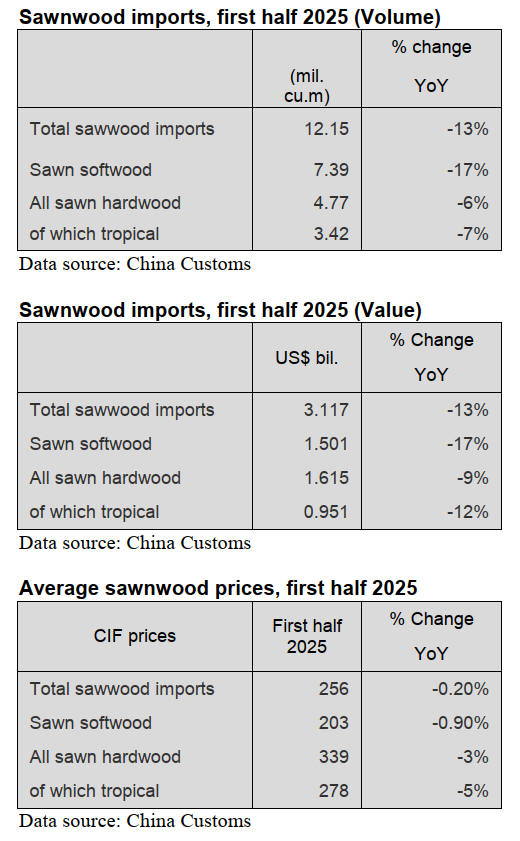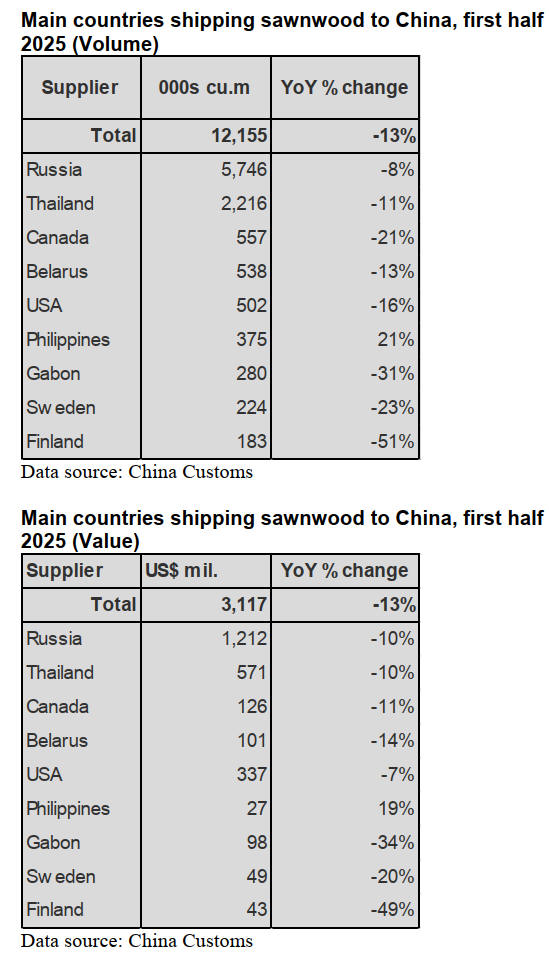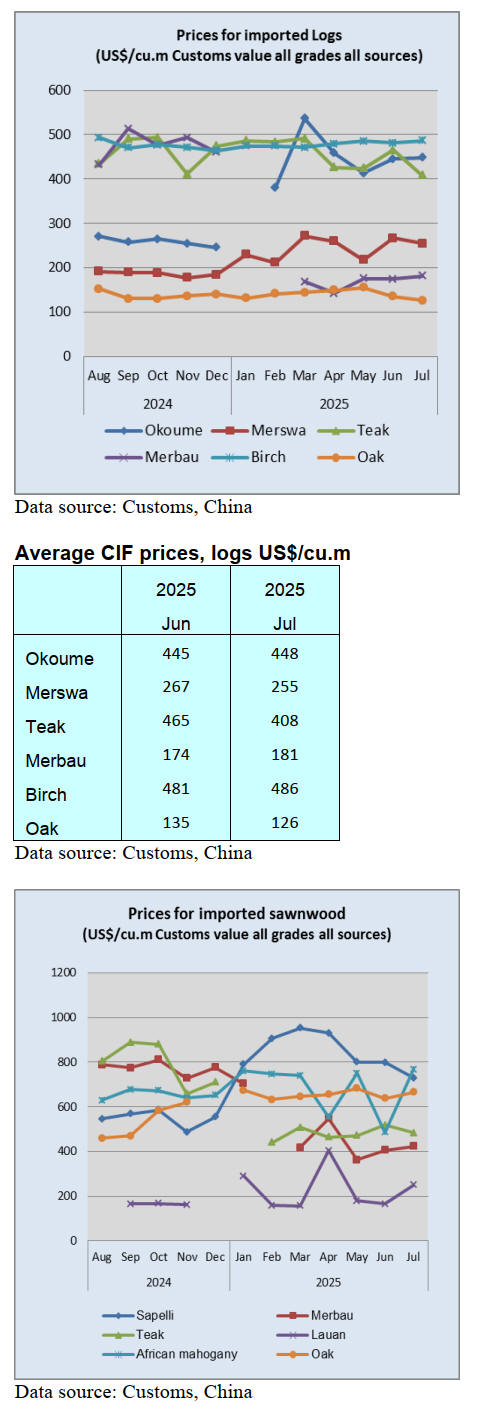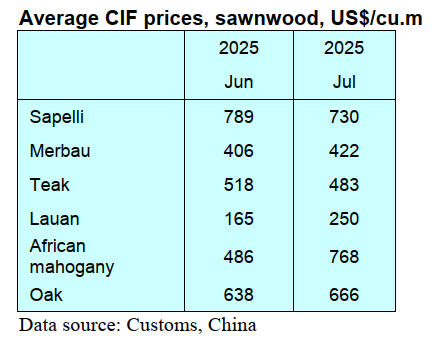US Dollar Exchange Rates of
25th
August
2025
China Yuan 7.15
Report from China
Decline in first half 2025 sawnwood imports
According to data from China Customs in the first half of
2025 sawnwood imports totalled 12.15 million cubic
metres valued at US$3.117 billion, down 13% in both
volume and value. The average CIF price for sawnwood
imports fell to US$256 per cubic metre over the same
period of 2024.
Of total sawnwood imports, sawn softwood imports fell
17% to 7.39 million cubic metres and accounted for 61%
of the national total, down 3 percentage points over the
same period of 2024. The average CIF prices for sawn
softwood imports dropped 0.9% year on year to US$203
per cubic metre over the same period of 2024.
Sawn hardwood imports declined 6% to 4.77 million cubic
metres in the first half of 2025. The average CIF price for
sawn hardwood imports dropped 3% to US$339 per cubic
metre over the same period of 2024.
Of total sawn hardwood imports, tropical sawnwood
imports were 3.42 million cubic metres valued at US$951
million, down 7% in volume and 12% in value and
accounted for about 28% of the national total. The average
CIF prices for tropical sawnwood fell 5% to US$278 per
cubic metre over the same period of 2024.

The decline in China’s sawnwood imports was attributed
mainly to the slump in activity in the real estate and
construction sectors. A seasonal slowdown caused by the
rain season in many provinces of China also slowed
overall demand for timber. China’s sawnwood imports
from most of top suppliers, especially from the largest
supplying country, Russia, fell in the first half of 2025.
Rise in sawnwood imports from the Philippines
China Customs has reported that in the first half of 2025
China’s sawnwood imports from the Philippines, alone
among the top suppliers, rose 21% over the same period of
2024.
Russia still was the largest supplier of sawnwood imports
in the first half of 2025 but the proportion of China’s
sawnwood imports from Russia declined to 47% in the
first half of 2025 from 65% in the first half of 2024.
Thailand was the second largest supplier of China’s
sawnwood imports in the first half of 2025 accounting for
18% of the national sawnwood imports total.
However, China’s sawnwood imports both from Russia
and Thailand fell 8% and 11% to 5.746 million cubic
metres and 2.216 million cubic metres respectively and it
was this downturn that impacted the overall decline in the
sawnwood imports.
China’s sawnwood imports from almost all of top
suppliers declined in the first half of 2025 as can be seen
in the table below.

Rise in sawn softwood imports from New Zealand
In the first half of 2025 China’s sawn softwood imports
from New Zealand, alone among the top suppliers, rose
41% over the same period of 2024. China’s sawn
softwood imports from almost all of top suppliers declined
year on year in the first half of 2025. (see below)

Decline in tropical sawnwood imports
China’s tropical sawnwood imports were 3.421 million
cubic metres valued at US$951 million, down 7% in
volume and 12% in value and accounted for about 28% of
the national total in the first half of 2025.
Thailand has been the largest supplier shipping tropical
sawnwood to China for many years. However, China’s
tropical sawnwood imports from Thailand in the first half
of 2025 dropped 11% to 2.216 million cubic metres valued
at US$571 million, down 10% over the same period of
2024 and accounted for 65% of the national total down 3
percentage points over the same period of 2024.
China’s tropical sawnwood imports from Gabon,
Myanmar, Malaysia, Cameroon and Indonesia fell 31%,
36%, 26%, 50% and 42% respectively in the first half of
2025.
In contrast, China’s tropical sawnwood imports from the
Philippines, Vietnam and the Republic of Congo rose
21%, 52% and 9% respectively in the first half of 2025.

It is worth noting that China’s tropical sawnwood imports
from PNG surged over 300% in the first half of 2025.
Global Timber Index – July 2025
Customs data showed that in the first half of this year
China's timber imports totalled US$5.811 billion, marking
a year-on-year decline of 14%. Breakdowns revealed that
log imports amounted to US$2.695 billion, down 18%
year-on-year, while sawnwood imports stood at US$3.117
billion, a drop of 13%. The sharp decline in timber imports
reflected, to some extent, the downturn in the real estate
market.
Currently, China's timber demand shows a mixed trend
with walnut and golden teak prices rising and that of some
other species remaining relatively stable. Since July timber
demand entered a period of adjustment due to high
temperatures and heavy rains. Construction activity
slowed and the output of furniture manufacturers also
declined compared to early this year.
Amidst the challenges the industry is hoping for a rebound
in demand during the traditional peak season of September
and October.
In July 2025 the GTI-China index registered 48.7%, a
decrease of 8.8 percentage point from the previous month
and fell below the critical value (50%) after 4 months
indicating that the business prosperity of the timber
enterprises represented by the GTI-China index shrank
from the previous month.
As for the twelve sub-indices, two (production and
purchase price) were above the critical value of 50%, one
index (market expectation) was at the critical value while
the remaining nine indices (new orders, export orders,
existing orders, inventory of finished products, purchase
quantity, import, inventory of main raw materials,
employees and delivery time) were all below the critical
value.
Compared to the previous month, the indices for
production, new orders, export orders, existing orders,
inventory of finished products, purchase quantity,
purchase price, import, inventory of main raw materials,
employees, delivery time and market expectation declined.
See: https://www.itto-
ggsc.org/static/upload/file/20250819/1755566095153001.pdf


|